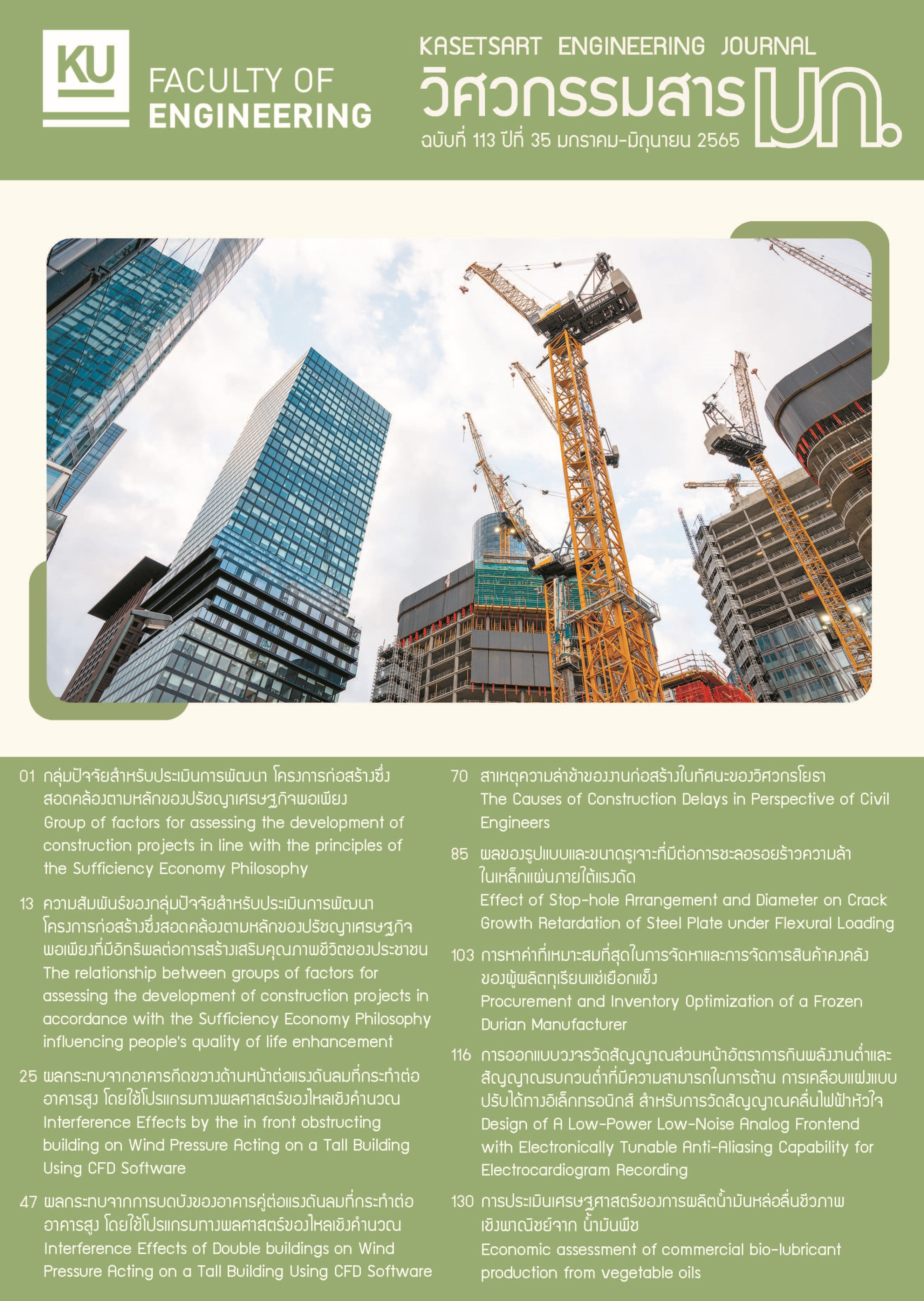Interference Effects of Double buildings on Wind Pressure Acting on a Tall Building Using CFD Software
Keywords:
wind load, high-rise building, Computational Fluid Dynamics, base shear, base momentAbstract
There are only few studies of wind load using Computational Fluid Dynamics (CFD) to investigate interference affects on wind pressure acting on a tall building, and mostly only a single obstructing building is considered. Moreover studies of interference effects on base shear and base moment caused by wind are very rare. although they are practically main building design parameters. therefore, this research has been conducted to study interference effects of the in front obstructing double buildings on wind pressure acting on a tall building. The main concerned parameters consist of distance and position of those obstructing double buildings. The same size of 2 obstructing buildings (including, size of small, medium and large) are modelled at various distances in front and located symmetry along the horizontal axis perpendicular to the front surface of the main building with the equal space to the length of the main building along wind direction for allowing wind flow passing through to act on the main building and then analyzed suing commercial CFD software. The obtained simulation results of wind pressure and wind forces acting on the main building are used to find the relationship for estimating the base shear and moment acting on the main building. From the study, if the reduced interference distance, u, less than 1, the interference by the obstructing buildings is small about 10%. But when the obstruct distance increases, the interference effects also increase and reach maximum of the reduced obstructing distance about 11. For u larges than 11, the interference effects decrease with the further obstructing distance. For comparison results of the simulation by CFD with the wind tunnel test, the obtained results are quite different since the wind tunnel test consists of more than 2 surrounding buildings and 1 large low rise neighbour building. For the prediction of base shear and moment acting on the main building caused by wind using the interference factors, the estimation gives smaller base shear and moment than those obtained from CFD simulation for about 53% and 56% respectively. And if compares with the wind tunnel test results, the estimation is about 27% and 38% lesser for base shear and moment respectively
References
Huang S, Li Q S, and Xu S (2007). Numerical evaluation of wind effects on a tall steel building by CFD. Journal of Constructional Steel Research, 63: 612–627.
Braun A L, and Awruch A M (2009). Aerodynamic and aeroelastic analyses on the CAARC standard tall building model using numerical simulation. Computers and Structures, 87: 564–581
Obasaju E D (1992). Measurement of forces and base overturning moments on the CAARC tall building model in a simulated atmospheric boundary layer. Journal of Wind Engineering and Industrial Aerodynamics, 40: 103–126.
Thepmongkorn S (2004). High frequency force balance model tests for a prediction of wind-induced forces and responses of buildings. The 9th National Convention on Civil Engineering, Phetchaburi, pp.120-125.
Verma S K, Roy A K, Lather S, and Sood M (2015). CFD Simulation for Wind Load on Octagonal Tall Buildings. SSRG International Journal of Civil Engineering, 129-134.
Mohotti D, Danushka K, Mendis P (2015). Wind Design of Slender Tall Buildings: CFD Approach. 6th International Conference on Structural Engineering and Construction Management, Kandy.
Mohotti D (2014). APPLICATION OF COMPUTATIONAL FLUID DYNAMICS (CFD) IN PREDICTING THE WIND LOADS ON TALL BUILDINGS- A CASE STUDY. 23rd Australasian Conference on the Mechanics of Structures and Materials, Byron Bay.
Sevalia J K, Desaib A K, Vasanwala S A (2012). EFFECT OF GEOMETRIC PLAN CONFIGURATION OF TALL BUILDING ON WIND FORCE COEFFICIENT USING CFD. International Journal of Advanced Engineering Research and Studies, 1: 127–130.
Parv B, Hulea R, Zoicas R (2012). Comparative study of wind effects on tall buildings using international codes and CFD. European Congress on Computational Methods in Applied Sciences and Engineering, Vienna.
Bairagi A K, Dalui S K (2014). Optimization of Interference Effects on High-Rise Buildings for Different Wind Angle Using CFD Simulation. Electronic Journal of Structural Engineering, 14: 39-49.
Dalui S K, Kar R, Hajra S (2015). Interference Effects on Octagonal Plan Shaped Tall building under Wind - A Case Study. SCIENTIFIC COOPERATIONS WORKSHOPS ON ENGINEERING BRANCHES, Istanbul.
Dagnew A K, Bitsuamlak G T (2010). LES evaluation of wind pressures on a standard tall building with and without a neighboring building. The Fifth International Symposium on Computational Wind Engineering.
Dagnew A K, Bitsuamalk G T, Merrick R (2009). Computational evaluation of wind pressures on tall buildings. 11th Americas Conference on Wind Engineering, San Juan.
Desai A K, Sevalia J K, Vasanwala S A (2014). Wind Interference Effect on Tall Building. World Academy of Science, Engineering and Technology International Journal of Civil, Environmental, Structural, Construction and Architectural Engineering, 8: 656-662.
Commonwealth Advisory Aeronautical Research Council (CAARC).
Downloads
Published
Issue
Section
License

This work is licensed under a Creative Commons Attribution-NonCommercial-NoDerivatives 4.0 International License.


